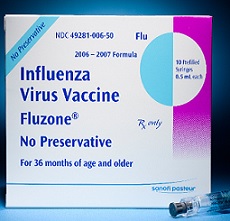By Catherine Smith
A growing number of health care facilities require that all of their employees get the influenza vaccine every year in order to help prevent their patients from getting the flu. It’s a well known fact that handwashing is the single most effective way to prevent the spread of infections; however, vaccinations work even better in preventing the spread of influenza. Voluntary vaccination isn’t enough, however, to achieve herd immunity within the hospital community. For our employees, refusing the vaccine without a preapproved religious or medical exemption is grounds for dismissal.
This is the second consecutive year my employer has mandated flu vaccines and many of our associates continue to speak out against this threat to their job security. I wasn’t clear about the validity of their concerns, so I did my own investigation and discovered the HealthCare Professionals for Vaccine Choice (HCPVC), which is a website dedicated to dispelling “myths” of flu vaccines with the following distortions of the facts:
Misleading Fact #1
There are 25 mcgs of mercury in the multi-dose vial of flu vaccine. Mercury is a neurotoxin to the brain.
 Even though the vaccines we use are single dose syringes, multi-dose vials are also available and they do contain mercury as a preservative. The type of mercury known to be a neurotoxin to the brain is methylmercury, which is found in certain types of fish. People, especially pregnant women are cautioned to avoid eating too much of it. Thimerosal, on the other hand, is ethylmercury, which is considered to be very safe. Stating this ‘fact’ is like saying we should avoid alcohol because drinking small amounts can cause blindness. One shouldn’t confuse methanol (methyl alcohol or wood alcohol) with ethanol (ethyl alcohol or grain alcohol).
Even though the vaccines we use are single dose syringes, multi-dose vials are also available and they do contain mercury as a preservative. The type of mercury known to be a neurotoxin to the brain is methylmercury, which is found in certain types of fish. People, especially pregnant women are cautioned to avoid eating too much of it. Thimerosal, on the other hand, is ethylmercury, which is considered to be very safe. Stating this ‘fact’ is like saying we should avoid alcohol because drinking small amounts can cause blindness. One shouldn’t confuse methanol (methyl alcohol or wood alcohol) with ethanol (ethyl alcohol or grain alcohol).
Misleading Fact # 2
If a person receives 5 flu vaccines in a lifetime, he/she is 10 times more likely to develop Alzheimer’s.
 Hugh Fundenberg, the world’s leading immunogeneticist, theorized that the accumulation of mercury and aluminum from flu vaccines greatly increases the risk of getting Alzheimer’s.
Hugh Fundenberg, the world’s leading immunogeneticist, theorized that the accumulation of mercury and aluminum from flu vaccines greatly increases the risk of getting Alzheimer’s.
The Alzheimer’s Association doesn’t agree. Dr. Fundenberg obviously has no comprehension of toxicology or pharmacokinetics.
Misleading Fact # 3
Flu Shots don’t work to prevent the flu. After a Flu Shot, you can still get the flu. There are 3 virus antigens in flu shots, in spite of the fact that there are 200 flu virus agents that mimic the flu.
This statement is only partially true. According to the CDC, the flu vaccine reduces the odds of getting the flu by 70% to 90%, and this year the vaccine contains four viral antigens. Not great, but certainly way better than nothing!
Misleading Fact # 4
After a Flu Shot, you can still spread the flu.
If it’s possible to get the flu even after receiving a flu shot, then it must be possible to spread the flu after receiving a flu shot.
Misleading Fact # 5
It is a lie for the media to report 24,000 deaths from flu each year as a scare tactic. The highest number of flu deaths was 3,006 in 1981, a far cry from 24,000-36,000 exaggerated deaths each year.
 The CDC does not know exactly how many people die from seasonal flu each year. The American Lung Association lumps influenza and pneumonia deaths together. In 1981, influenza and pneumonia deaths totaled 53,731 but only 3,006 death certificates had influenza listed as the cause of death. The CDC’s estimate of influenza related deaths is really scary. Older people, young children, pregnant women and people with certain health conditions (such as asthma, diabetes, or heart disease), and persons who live in facilities like nursing homes are at high risk for developing severe complications from the flu. That’s virtually 100% of our patients!
The CDC does not know exactly how many people die from seasonal flu each year. The American Lung Association lumps influenza and pneumonia deaths together. In 1981, influenza and pneumonia deaths totaled 53,731 but only 3,006 death certificates had influenza listed as the cause of death. The CDC’s estimate of influenza related deaths is really scary. Older people, young children, pregnant women and people with certain health conditions (such as asthma, diabetes, or heart disease), and persons who live in facilities like nursing homes are at high risk for developing severe complications from the flu. That’s virtually 100% of our patients!
Misleading Fact # 6
There is no evidence that health care workers are spreading flu to patients. There is no problem to fix by mandating Flu Shots.
 We might say that the evidence is not as strong as previously thought, but according to Politifact, this statement is completely false!
We might say that the evidence is not as strong as previously thought, but according to Politifact, this statement is completely false!
Misleading Fact # 7
Vaccinations are an invasive medical procedure which carry risks.
 Sometimes you can get a sore arm if you don’t relax, or a low-grade fever, but other adverse effects from the vaccine are rare, yet possible. I know of one associate who reported having more severe symptoms while getting the flu vaccine. The act of giving an injection itself can have risks. We always want an experienced nurse to give the shot in hopes of minimizing harm.
Sometimes you can get a sore arm if you don’t relax, or a low-grade fever, but other adverse effects from the vaccine are rare, yet possible. I know of one associate who reported having more severe symptoms while getting the flu vaccine. The act of giving an injection itself can have risks. We always want an experienced nurse to give the shot in hopes of minimizing harm.
Fact # 8
Vaccination does not mean immunization. The two terms are not synonymous.
This statement is true.
Upon reviewing these vaccine myths dispelled with facts, how does one contend with health care workers who are against mandatory influenza vaccinations? Health care is all about looking at the evidence and weighing the risks vs. the benefits. Just think about what the health care worker has to lose.
Now think about what the patient has to lose.
_________________________________________________________________________________________
 Cathy Smith has a Bachelor of Science in Biology from the University of Texas at San Antonio, and a Bachelor of Science in Pharmacy from the University of Texas at Austin. She is a licensed pharmacist in Texas and Michigan and has been a hospital pharmacist for twenty-three years. She’s currently a clinical hospital pharmacist at a southeast Michigan teaching hospital.
Cathy Smith has a Bachelor of Science in Biology from the University of Texas at San Antonio, and a Bachelor of Science in Pharmacy from the University of Texas at Austin. She is a licensed pharmacist in Texas and Michigan and has been a hospital pharmacist for twenty-three years. She’s currently a clinical hospital pharmacist at a southeast Michigan teaching hospital.
